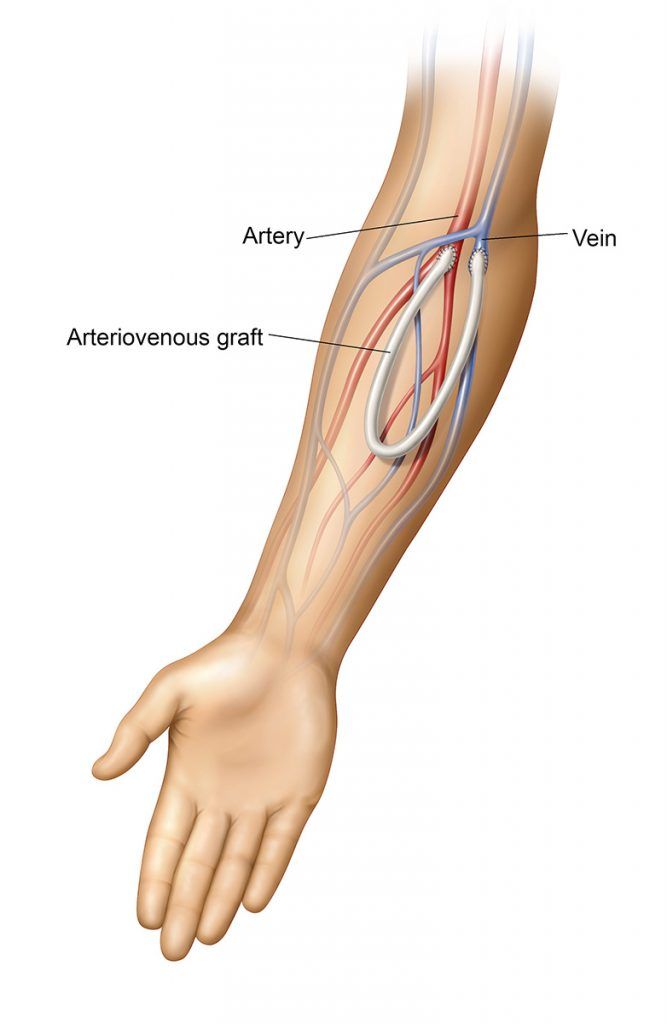What is an arteriovenous graft (AVG)?
An AV graft is an access option for haemodialysis patients with veins that are not strong enough for an arteriovenous fistula (AV fistula). Unlike an AV fistula, which directly connects an artery to a vein, an AV graft uses a small synthetic tube. One end of the graft attaches to a vein, and the other end connects to an artery.

Who may need an arteriovenous graft?
The AV fistula is considered the ‘gold standard’ for haemodialysis access, but it is not the best choice of access for everyone. However, if you have very damaged or occluded veins and arteries, an AV graft may not be a good option either.
Operation
During AV graft operation, a surgeon creates the graft by connecting the synthetic tube between an artery and a vein. The graft material is soft and pliable, minimising the risk of rejection. There are two types of grafts: straight and loop.
Arteriovenous grafts are made from synthetic materials such as polytetrafluoroethylene (PTFE or Gore-Tex) or polyurethane.
Location
AV grafts are usually placed in the arm, but the thigh can also be used as a location.
Blood vessel mapping
Before an AV graft operation, patients undergo blood vessel ‘mapping’ (with an ultrasound). This outpatient procedure helps determine the best site for graft placement, usually in the non-dominant arm.
Healing time
An AV graft typically heals within 3 to 4 weeks after placement. In some cases, in can be used in a few days, occasionally on the day after the operation.
Thrill indicator
After graft placement, patients can feel a vibration (or ‘thrill’) beneath the skin when placing their fingers over the graft. This indicates blood flow through the graft and that it is working.
Caring for your arteriovenous graft
After dialysis access surgery, you may experience some pain and swelling near the access site. This is normal and should improve within a few days. But before your AV graft can be used, it needs to heal.
Caring for your AV graft is very important. Besides washing your access site every day, you’ll need to check to see that the graft is still working properly. An easy trick is to remember the words look, listen and feel. Let’s take a look at how these words can help you remember how to check your AV graft on a daily basis.
- Look. Watch for signs of infection (redness, swelling or discharge) and changes in the appearance of the skin over and near the graft
- Listen. Check for the sound of blood moving through your graft by putting your ear, or a stethoscope if you have one, over your AV graft
- Feel. Ensure blood is flowing through the graft by feeling for the vibration (or thrill).
You should not strain the arm where your graft is located by picking up heavy objects, sleeping on it, putting undue pressure on it by wearing a watch, or carrying a handbag over the graft location.
Advantages of an arteriovenous graft
Whilst an arteriovenous graft is not considered the ‘gold standard’ haemodialysis access (that is a fistula), it is often considered the next best thing. It has some advantages over other types of haemodialysis vascular access (including a fistula and line). The advantages of an AV graft include:
- An AV graft is usually ready for use within anywhere from a matter of days (‘early use’ grafts) to 3-4 weeks of being placed (compared to 6-8 weeks for a fistula)
- An AV graft has a lower chance of infection than a haemodialysis line
- Once it heals, you can shower, bath or swim.
Disadvantages of an arteriovenous graft
Despite the advantages to this type of dialysis access, there are disadvantages as well, which is why it is not considered the best choice for everyone.
- An AV graft does not usually last as long as an AV fistula does
- AV grafts are more prone to clotting than AV fistulas are
- Since they are artificial, they are more prone to infection than fistulas
- Unlike with a haemodialysis line, needles are still required to access the AV graft.
For some people, AV grafts are the best option for dialysis access. And if you are one of these people, remember that taking care of your access will help your access take care of you.
Summary
We have described what is an arteriovenous graft (AVG). We hope this has been helpful.
Other resources
What is a haemodialysis line?
What is a AV fistula?
Patient information leaflet (Dudley hospital)
Having a fistula or graft (patient information leaflet from UHCW, Coventry)
Last Reviewed on 14 May 2024
